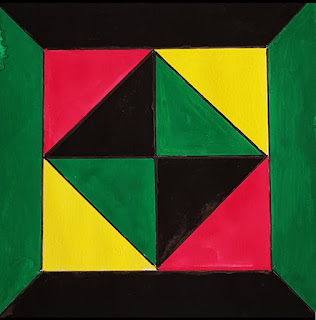2021
Gouache
6 x 6 inches
This geometric abstract painting series consists of a total of six pieces divided into three pairs. Nos 1 and 2 will be showcased here over the next few weeks. This series — Being Black, Being Abstract, Being Invisible — started its life in my 'Race' and Representation sketchbook, an explorative art project that I worked on in 2021.
For the paintings displayed here, inspiration came from African American artist Faith Ringgold, who first used the Kuba design of eight triangles within a square in her painting Love Black Life (1969) where she borrowed a compositional format from Kuba textile designs of the Democratic Republic of Congo. Within Faith Ringgold's design, she created a multiplicity of word associations, simultaneously reading "LOVE BLACK LIFE."
Working on Being Black, Being Abstract, Being Invisible, knowing of its African history and African American artists' influence, felt like I wasn't working completely alone.
Being Black, Being Abstract, Being Invisible No 2/2
2021
Canva Graphic Design
8 x 4.5 inches
The title Being Black, Being Abstract, Being Invisible came first, along with the text: 'Black People DO Have HISTORY,' which I incorporated using Canva graphic design software, which evolved into the second piece, made specifically to accompany a piece of creative writing — nonfiction narrative: 'It's Not Just My Skin I'm Living In'.
The existence and importance of Black history was a relevant response to counteract the notion and belief that 'Black people don't have a history'. This became a significant feature of the creative nonfiction narrative, with its broad theme of racism in the workplace.
Genre:
A creative nonfiction narrative was chosen as the best genre to tell a true story of a historical event that took place between 2003-2004. The short story form enabled me to use literary/fiction techniques such as setting, description, and tension.
I used recollected conversation, rather than verbatim dialogue. All of these techniques worked as a method for storytelling and as a means of presenting factual information.
Theme of Racism in the Workplace:
My aim was to write a story that could be related to any workplace in the UK, especially, although not exclusively, one with a predominantly white majority workforce and specifically one without a history of Black managers.
The aim was not to convince the reader that racism in the workplace exists, instead, the aim was to document the experiences of racism from the perspective of one Black female manager, i.e. myself, as a critical race counter-storytelling response, thereby creating an opportunity for open conversation.
'Race', Law & Literature & The Importance of a Single Story:
One of the things that a creative nonfiction narrative can do is open a single story and expand the relationship between 'race', law and literature, to interrogate the literary representation of marginalised people. This enables a writer to recraft what and how we think about the past, as we are still living with its historical legacies.
The triad of 'race', law and literature provides a fascinating way to explore, examine and explain the subject matter of racism in the workplace. Storytelling can also be a creative method for mapping out legal arguments/intervention, providing a roadmap outside of restrictions of legal acts/actions.
Literature references can support a story by bringing in an important point of view and relevant position to expand critical thinking.
Narrative:
To manipulate time, I chose two first-person narratives: 1. As the omniscient narrator and authorial voice telling the story in the past, which is a usual way of telling a story. 2: As the reflective narrator, to show how creating and exploring the story now sheds new light not just on the single story but also on the wider and contemporary issue of racism in the workplace.
My aim was to merge the two narrators from time to time when necessary and I certainly didn't aim to make them two distinct and separate entities. I added hashtag symbols merely to add a pause so as to help clarify the different aspects and layers that the story brought forth while telling it.
A balance of omniscient and reflective narrators ensured a consistent writing style that was conversational while being informative and factually accurate.
Comments welcome!
Thanks for reading.






No comments:
Post a Comment